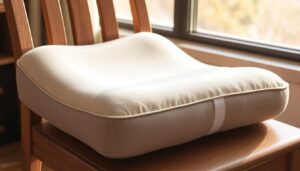Mothers often do many things at once. They take care of their kids and do household chores. This can make their bodies hurt and ache every day.
Keeping a good alignment is key to reducing everyday aches. Yoga, stretching, and strengthening exercises can help. These simple steps can make it easier for moms to handle their busy lives.
Key Takeaways
- Good alignment is essential for reducing everyday aches and pains.
- A combination of yoga, stretching, and strengthening exercises can improve posture.
- Incorporating simple exercises into daily routines can enhance strength, flexibility, and balance.
- Mothers can benefit from making small changes to their daily habits to improve their overall well-being.
- Simple exercises can help reduce muscle tension and improve overall health.
The Hidden Toll of Poor Posture on a Mom’s Body
Mothers often ignore how their daily habits affect their posture. This can lead to health problems. Taking care of kids, doing chores, and more can harm their posture.
Common Posture-Related Pain Points for Mothers
Mothers often feel pain in certain areas because of bad posture. The neck and upper back, and the lower back, are usually affected.
Neck and Upper Back Strain
Looking down to care for kids can hurt the neck and upper back. Looking at devices a lot can make it worse. This can cause pain and discomfort.
Lower Back Pain Patterns
Lower back pain is common in mothers. It often comes from bad lifting or standing too long. This pain can really hurt and make daily tasks hard.
The Long-Term Impact of Postural Neglect
Ignoring posture can cause long-term problems. This includes chronic pain and less mobility.
Chronic Pain Development
Chronic pain can start if you don’t fix your posture. It can make life less enjoyable and force you to rely on pain meds.
Mobility and Energy Limitations
Poor posture can also lower your energy and mobility. This makes it tough to do daily tasks. As one expert says,
“Good posture is key to keeping energy and avoiding long-term harm to muscles and bones.”
Understanding posture’s effects and fixing it can help mothers avoid pain. It supports a healthy ergonomic lifestyle and overall well-being.
Understanding Your Body’s Alignment Needs
Reducing everyday aches starts with proper body alignment. Good posture means your body is set up to avoid muscle strain. This is especially important for moms who often face physical challenges.
What Proper Alignment Actually Looks Like
Proper alignment starts with the spine. Keeping your spine in a neutral position is key.
The Neutral Spine Position
A neutral spine is not perfectly straight but has gentle curves. It’s important to know the spine has three natural curves. These curves are at the neck, mid-back, and lower back. Keeping these curves is crucial for good posture.
Shoulder and Neck Alignment
Good alignment also means keeping your shoulders back and relaxed. Avoid slouching or leaning forward. Your neck should be in line with your spine, not stretched or tilted.

Self-Assessment: Identifying Your Posture Problems
To fix your posture, first find out what’s wrong. A simple self-check can show you common alignment issues.
Mirror Check Method
Stand in front of a mirror and look at your posture. Make sure your ears are in line with your shoulders. Check if your shoulders are even. See if your weight is balanced on both feet.
Common Misalignment Patterns in Mothers
Mothers often have specific alignment problems due to daily tasks. These include forward head posture and uneven shoulders.
| Posture Issue | Description | Correction Tip |
|---|---|---|
| Forward Head Posture | The head is positioned in front of the shoulders. | Keep ears in line with shoulders. |
| Uneven Shoulders | One shoulder is higher than the other. | Practice shoulder rolls and stretches. |
| Lower Back Arch | Excessive curvature of the lower back. | Strengthen core muscles. |
The Mom-Specific Posture Challenges
Momhood brings lots of joy but also special posture challenges. These can hurt a mom’s health. Moms often have bad posture because of caring for kids.
Being a mom changes your body in big ways. This can cause posture problems. Knowing these issues helps moms avoid pain and feel better.
Pregnancy and Postpartum Posture Changes
Pregnancy changes your body a lot. Your center of gravity shifts, making your back curve more. After having a baby, your tummy muscles get weak. This makes mom alignment harder.
- Maintaining a neutral spine during pregnancy
- Engaging in postpartum core strengthening exercises
- Being mindful of posture during feeding and caring for the newborn
Carrying Children and Heavy Diaper Bags
Carrying kids and heavy diaper bags hurts your back and shoulders. This can cause long-term pain. It’s important to prevent pain.
- Using proper lifting techniques to avoid straining the back
- Distributing the weight of diaper bags and other items evenly
- Considering the use of strollers or baby carriers to reduce the load
Bending, Lifting, and Multitasking Strain
Moms often bend, lift, and do many things at once. This can hurt your body. Good posture and breaks help a lot.
- Bending at the knees instead of the waist
- Lifting with the legs rather than the back
- Prioritizing tasks to reduce the need for multitasking
Essential Posture Tips for Moms: The Foundation
Good posture is not just about looks. It’s key for a healthy, pain-free life for moms. Keeping the right posture helps avoid muscle and joint pain.

Core Strengthening Basics for Busy Moms
Building a strong core is vital for good posture. A strong core helps support the spine, lowering back pain risks. Busy moms can do simple exercises to boost their core strength.
5-Minute Core Activation Exercises
Doing short, regular core exercises helps a lot. Here are some examples:
- Planks: Hold for 30 seconds to engage core muscles.
- Bridges: Lie on your back with knees bent and lift your hips.
- Leg raises: Lie on your back and raise your legs straight up.
Incorporating Core Awareness Throughout the Day
Being aware of your core during daily tasks also improves posture. For example, pulling in your belly while sitting or standing strengthens your core over time.
The 5-Minute Daily Alignment Routine
Along with core exercises, a daily alignment routine is crucial. It can be as simple as a morning stretch and a bedtime check.
Morning Reset Sequence
Starting the day with simple stretches aligns your body. This includes:
- Standing tall with feet hip-width apart.
- Stretching the arms overhead and lengthening the spine.
- Gently tilting the head from side to side to loosen the neck.
Bedtime Alignment Check
Before bed, check your posture to find tension spots. Look at your shoulders, hips, and ankles while lying down.
By following these posture tips, moms can live a healthier life. They’ll avoid pain from bad posture.
Getting good mom alignment takes time and effort. But with regular practice, it becomes a natural part of your day. It leads to a healthier, more comfortable life.
Correcting Posture While Caring for Infants
A new baby brings joy, but it also means we must watch our posture. New moms need to keep their posture right to avoid pain.
Proper Nursing and Bottle Feeding Positions
It’s important to sit right while nursing or bottle feeding. Using pillows can help keep your back and shoulders comfy.
Supportive Pillows and Props
Pillows or a nursing pillow can support the baby. This helps keep your back and shoulders from getting sore.
Neck and Shoulder Protection Techniques
Pay attention to how you hold your neck and shoulders while feeding. Keeping your neck straight helps avoid back pain.
Baby-Wearing Techniques That Protect Your Back
Baby-wearing is great for keeping your hands free. But, it’s important to wear the baby right to avoid back pain.
Carrier Selection and Adjustment
Picking the right baby carrier and adjusting it right is key. It helps spread out the baby’s weight, easing back pain.
Weight Distribution Principles
Knowing how to spread out the baby’s weight is important. It helps avoid back pain.
Crib and Changing Table Ergonomics
The design and height of cribs and changing tables matter a lot. They should be at a comfy height to avoid bending and straining.
| Ergonomic Tip | Benefit |
|---|---|
| Adjust crib height to waist level | Reduces bending and straining |
| Use a changing table with storage | Minimizes reaching and stretching |
| Position changing table near supplies | Reduces movement and strain |
By using these tips, moms can lower their chance of back and shoulder pain from caring for babies.
Posture Solutions for Toddler and School-Age Parenting
As kids grow, moms face new posture challenges. These can lead to aches if not fixed. Moms need to adjust their posture to stay comfortable and avoid pain.

Lifting and Carrying Growing Children
Lifting and carrying kids is common for moms. As kids get bigger, it puts more strain on moms. Learning the right lifting techniques is key to avoid injury and pain.
Hip-Hinging Technique
The hip-hinging technique is a good way to lift. It means bending at the hips and knees, not the waist. This helps keep the back straight and uses leg muscles to lift, protecting the spine.
Alternating Carrying Sides
Switching the side you carry your child on helps. It spreads the weight evenly. This habit can help keep your body balanced and comfortable.
Playground and Floor Play Positioning
When playing with kids on the playground or floor, watch your posture. Kneeling or sitting on the floor with back support is best. It helps avoid back strain.
“Good posture is essential for moms to maintain their health and be able to care for their children effectively.”
Car Seat and Stroller Ergonomics
Make sure car seats and strollers fit both the child and mom well. Using them in a way that supports good posture is important. It helps prevent strain and discomfort.
| Device | Adjustment Tip | Benefit |
|---|---|---|
| Car Seat | Adjust to child’s size, ensure easy access | Reduces strain on back and arms |
| Stroller | Adjust handle to mom’s height | Prevents back and shoulder strain |
By using these posture tips, moms can lower their risk of pain. This is especially true for parenting toddlers and school-age kids.
Household Chore Modifications to Prevent Pain
Making simple changes to household tasks can help moms avoid pain. These adjustments make daily chores easier on the body.
Kitchen and Cooking Ergonomics
Cooking can be hard on the body. Counter height adjustments are key. Having counters at a comfy height stops the need to bend and strain.
Counter Height Adjustments
Counters should be 2-3 inches below your bent elbow. This makes it easier on your back and shoulders.
Meal Prep Posture Techniques
Good posture is important when cooking. Stand straight and don’t bend. Using a stool for high or low tasks is also helpful.
Laundry and Cleaning Without the Strain
Laundry and cleaning can be tough. Using ergonomic tools helps. For example, a laundry sorter with wheels makes carrying easier.
Grocery Shopping and Carrying Techniques
Grocery shopping can also hurt your body. Use a cart that supports you well. Carry bags close to your body and avoid heavy lifting.
By using these ergonomic tips, moms can avoid pain. They can live a healthier, more comfortable life.
Creating an Ergonomic Home Environment
An ergonomic home is key for good posture and comfort. It’s especially important for busy moms. A few simple changes can help avoid daily aches and pains.
Setting Up Mom-Friendly Spaces
Creating spaces for moms in the home needs careful thought. Focus on areas like nursing and feeding, and work-from-home spots.
Nursing and Feeding Stations
A comfy nursing and feeding spot is a big help. Use a chair with good back support. Place the baby at a height that doesn’t hurt your back or neck.
Work-From-Home Setups
Many moms work from home. Make sure your workspace is set up right. This means the computer monitor is at eye level, and you use an ergonomic keyboard and mouse. Don’t forget a supportive chair.

Essential Ergonomic Tools Worth the Investment
Getting ergonomic tools is a smart move. They help you feel better and avoid injuries. Look at supportive chairs and accessories that help your posture.
Supportive Seating Options
A good chair is vital for posture. Look for one that adjusts and has lumbar support. A footrest can also help.
Posture-Supporting Accessories
Tools like back supports and ergonomic mouse pads are also helpful. They make your workspace better and reduce body strain.
By making these changes, moms can make their homes healthier. This makes daily life easier to handle.
Digital Device Posture: Preventing Tech Neck and Text Thumb
Digital devices are everywhere, causing problems like tech neck and text thumb. We spend a lot of time on phones, tablets, and computers. It’s important to keep good posture to avoid these issues.
Proper Phone and Tablet Positioning
To avoid neck and wrist strain, place your devices right. Here are some tips:
Eye-Level Viewing Techniques
- Hold your device at eye level to avoid tilting your head down.
- Use a stand or holder to prop up your device, reducing strain on your neck.
Hand and Wrist Protection
- Hold your device with both hands to distribute the weight evenly.
- Take regular breaks to stretch your wrists and fingers.
Computer Workstation Setup for Busy Moms
Working from home or spending lots of time on computers? An ergonomic workstation is key. Here are some important points:
Screen Height and Distance
- Position your monitor directly in front of you, at a distance of about 20-25 inches.
- The top of the monitor should be at eye level or slightly below.
Chair and Keyboard Positioning
- Use a chair with good lumbar support and adjust it so your feet are flat on the floor.
- Keep your keyboard close to your body and wrists straight while typing.
By making these simple changes, busy moms can lower their risk of tech neck and text thumb. This makes computing healthier and more comfortable.
Quick Relief Techniques for Mom’s Everyday Aches
As a mom, you face aches and pains often. But, there are quick ways to feel better. Motherhood is full of joy, but it also has physical challenges. Simple relief strategies can greatly improve your health.
5-Minute Stretches for Neck and Shoulder Tension
Neck and shoulder tension are common in moms. Simple stretches can help. Try a Chin Tuck: Stand or sit straight and slowly tuck your chin towards your chest. Hold for 15 seconds, then repeat 10 times.
Another good stretch is the Shoulder Roll. Roll your shoulders forward and backward in a circle. Do this 10 times to loosen tight muscles.
Lower Back Pain Relief Strategies
Lower back pain is common in moms. It often comes from lifting, bending, or bad posture. There are two main ways to ease this pain: Decompression Techniques and Gentle Mobility Exercises.
Decompression Techniques
Decompression reduces spine pressure, easing lower back pain. A good method is the Knee to Chest Stretch. Lie on your back, bring one knee to your chest, and hold for 30 seconds. Switch legs and repeat.
Gentle Mobility Exercises
Gentle exercises improve flexibility and reduce stiffness. Try Pelvic Tilts. Lie on your back with knees bent and feet flat. Tilt your pelvis up and then back down, repeating 10 times.
Wrist and Hand Strain Solutions
Wrist and hand strain is common in moms. It comes from lifting, carrying heavy bags, or doing repetitive tasks. To ease this, try Wrist Extensions. Hold your arm straight out and lift your hand up with the other hand. Hold for 15 seconds, then repeat 10 times.
| Relief Technique | Description | Benefit |
|---|---|---|
| Chin Tuck | Stand or sit with good posture and tuck your chin towards your chest. | Relieves neck tension |
| Shoulder Roll | Roll your shoulders in a circular motion. | Loosens shoulder muscles |
| Knee to Chest Stretch | Lie on your back and bring one knee towards your chest. | Decompresses lower back |
Incorporating Movement Breaks Into Your Mom Schedule
Making time for brief moments of movement can help a lot. It’s good for a mom’s posture and health. Busy moms often forget about their own health. But, short breaks can make a big difference.
Micro-Exercise Opportunities Throughout the Day
Looking for chances to move a little can be easy. You can make daily tasks into chances to move. This way, you can stay active without losing time.
Playful Movement With Children
Playing with your kids is a great way to move. Dancing, playing tag, or running around is fun and good for your back.
Household Task Movement Integration
Even doing chores can help you move. Leg lifts while folding laundry or squats while picking up toys are good. These small actions help a lot.
Family-Friendly Movement Activities
Doing activities together is good for everyone. Going for a walk, biking, or playing sports is fun for all. It keeps everyone healthy and happy.
Adding these breaks to your day helps a lot. It improves your posture and reduces pain. This makes life better for busy moms.
When to Seek Professional Help for Posture Issues
Posture problems can get worse if not fixed right away. Moms face special challenges that can hurt their posture, from being pregnant to taking care of little kids. Knowing when to get help is key for pain prevention and living an ergonomic lifestyle.
Warning Signs That Require Medical Attention
Some symptoms mean you need to see a doctor for posture issues. Knowing these signs can stop problems from getting worse.
Pain That Disrupts Sleep or Daily Activities
If pain from bad posture keeps you awake or stops you from doing things, you need help. Chronic pain can really lower your quality of life. Don’t ignore it.
Numbness, Tingling, or Weakness
Feeling numb, tingly, or weak in your arms or legs is a bad sign. It might mean nerves are getting squished or hurt because of bad posture. You should see a doctor fast to avoid lasting harm.
Finding the Right Specialists for Posture Correction
When you know you need help for posture, finding the right expert is next. Many healthcare pros can help, based on what you need.
Physical Therapists and Posture Experts
Physical therapists can fix posture problems with exercises, hands-on therapy, and teaching you how to move right. They give you posture tips and a pain prevention plan just for you.
Complementary Approaches for Alignment
Along with doctors, things like chiropractic care, osteopathy, and yoga can really help. They focus on making your whole body work better together. You can use them with regular treatments.
Conclusion: Building Lasting Posture Habits for Pain-Free Motherhood
Mothers can make their lives pain-free by using good posture tips. Keeping the right mom alignment is key. An ergonomic lifestyle helps prevent pain too.
It’s important to practice good posture every day. Start by using the tips from before. This includes lifting right, making home chores easier, and taking breaks to move.
Good posture habits help avoid daily aches and pains. An ergonomic lifestyle does more than just prevent pain. It also makes you feel better overall.
When mothers focus on their posture, they live healthier and more comfortably. This lets them take care of their families better.
FAQ
What is the most common posture-related pain points for mothers?
Mothers often feel pain in their lower back, neck, and shoulders. This is because of bad posture. Carrying children, bending, and lifting can cause it.
How can I self-assess my posture to identify potential problems?
Stand up straight and imagine a string pulling your head up. Make sure your ears are in line with your shoulders. Your shoulders should be relaxed.
You can also stand with your back against a wall. See if your shoulders, hips, and heels touch the wall.
What are some simple exercises I can do to strengthen my core and improve my posture?
Try planks, bridges, and pelvic tilts to strengthen your core. Gentle stretches can also help loosen tight muscles and improve flexibility.
How can I maintain good posture while caring for my infant?
Use proper nursing and bottle-feeding positions. Consider a baby-wearing sling or carrier to ease back strain. Adjust the height of your crib and changing table to avoid bending.
What are some ergonomic tips for setting up my home workspace?
Make sure your chair is at a comfortable height. Your monitor should be at a distance that lets you gaze slightly downward. A standing desk or document holder can also help reduce neck and back strain.
How can I prevent tech neck and text thumb while using digital devices?
Hold your phone or tablet at eye level. Take breaks to stretch your neck and shoulders. Using a phone holder or stand can also reduce strain on your neck and wrists.
What are some quick relief techniques for common aches and pains?
Stretching, and using heat or cold therapy can help. Gentle exercises can also loosen tight muscles and improve flexibility.
How can I incorporate movement breaks into my busy schedule as a mom?
Take short breaks to stretch, jump up and down, or do squats. Involve your children in physical activities like playing tag or dancing together.
When should I seek professional help for posture issues?
Seek professional help if you have persistent pain or discomfort. If you notice big changes in your posture or alignment, get help. A healthcare professional can help find the cause and create a treatment plan.







